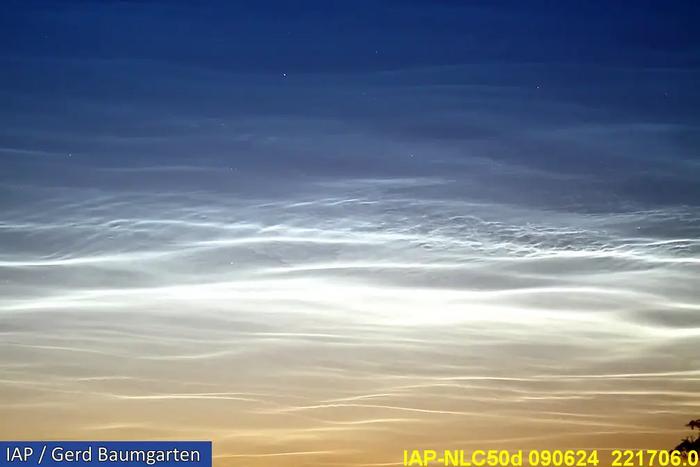Fukuoka, Japan—In a paper published in Geophysical Research Letters, researchers have discovered that the turbulence in the thermosphere exhibits the same physical laws as the wind in the lower atmosphere. Furthermore, wind in the thermosphere predominantly rotates in a cyclonic direction, in that it rotates counterclockwise in the Northern Hemisphere and clockwise in the Southern Hemisphere.

Credit: Gerd Baumgarten/Leibniz-Institute of Atmospheric Physics
Fukuoka, Japan—In a paper published in Geophysical Research Letters, researchers have discovered that the turbulence in the thermosphere exhibits the same physical laws as the wind in the lower atmosphere. Furthermore, wind in the thermosphere predominantly rotates in a cyclonic direction, in that it rotates counterclockwise in the Northern Hemisphere and clockwise in the Southern Hemisphere.
The findings reveal a new unified principle for the Earth’s varied environmental systems and can potentially improve future forecasting of both earth and space weather.
One time or another we’ve tuned in to see the latest weather forecast, and while they give us a good idea of our daily atmospheric conditions the research that goes into studying how Earth’s air moves around is dizzyingly complex.
“At the fundamental level, we study the interplay of kinetic energy in the atmosphere at different sizes and scales, that energy is mostly in the form of wind and turbulence. Over the decades, a massive amount of data has given us insight into how this energy flows and dissipates to affect the weather in the troposphere, the lowest layer of the atmosphere” explains Professor Huixin Liu of Kyushu University’s Faculty of Science who led the study. “My research focuses on the movements in the upper atmosphere, specifically the thermosphere, where we explore the corresponding laws governing the dynamics and energy flow in the region.”
The thermosphere is a section of the atmosphere roughly 80-550 km above sea level and is often referred to as the gateway to space. It is a critical region for space operation, and is where you will find the International Space Station as well as most satellites. It is also where auroras are formed.
Liu collaborated with meteorology researcher Dr. Facundo L. Poblet of Leibniz Institute of Atmospheric Physics at the University of Rostock, whose work focuses on the dynamics and turbulence in the lower atmosphere below an altitude of 100 km.
“My research is in space physics, and I wanted to see if we could apply his meteorological methods to my research domain,” explains Liu.
The team analyzed the thermosphere wind data from two satellites, the Challenging Minisatellite Payload (CHAMP) and the Gravity Field and Steady State Ocean Circulation Explorer (GOCE). With the data, the team caculated the third-order structure function of the wind, a statistical quantity that provides information on the underlying turbulence. To their astonishment, they discovered that the thermosphere exhibits a similar scaling law from that of the lower atmosphere.
“This means that both the thermosphere and the troposphere—despite having drastically different atmospheric compositions and dynamics—follow the same physical laws. How turbulence moves, forms, and dissipates in these two regions are very similar,” continues Liu.
Despite remarkable strides in understanding the thermosphere, the intricate interplay of turbulence has remained largely elusive, and the team is happy that their findings shed new light onto this underexplored aspect of near-space dynamics.
“Similar to atmospheric weather forecasting, comprehending the energy distributions in the thermosphere is vital to advance our understanding of space dynamics,” concludes Liu. “We hope these findings can be used to improve space weather forecasting and ensuring the continued functionality and safety of satellite-based technologies essential to everyday life.”
###
For more information about this research, see “Third-order Structure Functions of Zonal Winds in the Thermosphere using CHAMP and GOCE Observations,” Facundo L. Poblet, Huixin Liu, Jorge L. Chau Geophysical Research Letters,
About Kyushu University
Founded in 1911, Kyushu University is one of Japan’s leading research-oriented institutes of higher education, consistently ranking as one of the top ten Japanese universities in the Times Higher Education World University Rankings and the QS World Rankings. The university is one of the seven national universities in Japan, located in Fukuoka, on the island of Kyushu—the most southwestern of Japan’s four main islands with a population and land size slightly larger than Belgium. Kyushu U’s multiple campuses—home to around 19,000 students and 8000 faculty and staff—are located around Fukuoka City, a coastal metropolis that is frequently ranked among the world’s most livable cities and historically known as Japan’s gateway to Asia. Through its VISION 2030, Kyushu U will “drive social change with integrative knowledge.” By fusing the spectrum of knowledge, from the humanities and arts to engineering and medical sciences, Kyushu U will strengthen its research in the key areas of decarbonization, medicine and health, and environment and food, to tackle society’s most pressing issues.
Journal
Geophysical Research Letters
Method of Research
Data/statistical analysis
Subject of Research
Not applicable
Article Title
Third-order Structure Functions of Zonal Winds in the Thermosphere using CHAMP and GOCE Observations
Article Publication Date
3-Jun-2024



